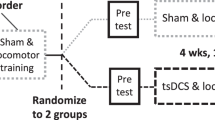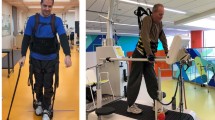Abstract
Study design:
Observational, cross-sectional study from a convenience sample with pretest/posttest data from a sample subset.
Objectives:
Determine the presence of walking-related arm swing after spinal cord injury (SCI), its associated factors and whether arm swing may change after locomotor training (LT).
Setting:
Malcom Randall VAMC and University of Florida, Gainesville, FL.
Methods:
Arm movement was assessed during treadmill stepping, pre-LT, in 30 individuals with motor incomplete SCI (iSCI, American Spinal Injury Association Impairment Scale grade C/D, as defined by the International Standards for Neurological Classifications of SCI, with neurological level of impairment at or below C4). Partial body weight support and manual-trainer assistance were provided, as needed, to achieve stepping and allow arm swing. Arm swing presence was compared on the basis of cervical versus thoracic neurological levels of impairment and device type. Leg and arm strength and walking independence were compared between individuals with and without arm swing. Arm swing was reevaluated post-LT in the 21 out of 30 individuals who underwent LT.
Results:
Of 30 individuals with iSCI, 12 demonstrated arm swing during treadmill stepping, pre-LT. Arm movement was associated with device type, lower extremity motor scores and walking independence. Among the 21 individuals who received LT, only 5 demonstrated arm swing pre-LT. Of the 16 individuals lacking arm swing pre-LT, 8 integrated arm swing post-LT.
Conclusion:
Devices routinely used for walking post-iSCI appeared associated with arm swing. Post-LT, arm swing presence increased. Therefore, arm swing may be experience dependent. Daily neuromuscular experiences provided to the arms may produce training effects, thereby altering arm swing expression.
Similar content being viewed by others
Log in or create a free account to read this content
Gain free access to this article, as well as selected content from this journal and more on nature.com
or
References
Craik R, Herman R, Finley F . Advances in behavioral biology. In: Herman R, Grillner S, Stein P, Stuart D (eds). Human Solutions for Locomotion: Interlimb Coordination. Plenum Press: New York, 1976, pp 51–64.
Collins SH, Adamczyk PG, Kuo AD . Dynamic arm swinging in human walking. Proc Biol Sci 2009; 276: 3679–3688.
Zehr EP, Hundza SR, Vasudevan EV . The quadrupedal nature of human bipedal locomotion. Exerc Sport Sci Rev 2009; 37: 102–108.
Barthelemy D, Nielsen JB . Corticospinal contribution to arm muscle activity during human walking. The Journal of Physiology 2010; 588 (Part 6): 967–979.
Zehr EP, Collins DF, Chua R . Human interlimb reflexes evoked by electrical stimulation of cutaneous nerves innervating the hand and foot. Exp Brain Res 2001; 140: 495–504.
Calancie B, Alexeeva N, Broton JG, Molano MR . Interlimb reflex activity after spinal cord injury in man: strengthening response patterns are consistent with ongoing synaptic plasticity. Clin Neurophysiol 2005; 116: 75–86.
Edgerton VR, Tillakaratne NJ, Bigbee AJ, de Leon RD, Roy RR . Plasticity of the spinal neural circuitry after injury. Annu Rev Neurosci 2004; 27: 145–167.
Huang HJ, Ferris DP . Neural coupling between upper and lower limbs during recumbent stepping. J Appl Physiol 2004; 97: 1299–1308.
Kawashima N, Nozaki D, Abe MO, Nakazawa K . Shaping appropriate locomotive motor output through interlimb neural pathway within spinal cord in humans. J Neurophysiol 2008; 99: 2946–2955.
Stephenson JL, De Serres SJ, Lamontagne A . The effect of arm movements on the lower limb during gait after a stroke. Gait Posture 2010; 31: 109–115.
American Spinal Injury Association (revised 2002). International Standards for Neurological Classification of Spinal Cord Injury.
Dittuno PL, Ditunno Jr JF . Walking index for spinal cord injury (WISCI II): scale revision. Spinal Cord 2001; 39: 654–656.
Behrman AL, Lawless-Dixon AR, Davis SB, Bowden MG, Nair P, Phadke C et al Locomotor training progression and outcomes after incomplete spinal cord injury. Phys Ther 2005; 85: 1356–1371.
Ford MP, Wagenaar RC, Newell KM . The effects of auditory rhythms and instruction on walking patterns in individuals post stroke. Gait Posture 2007; 26: 150–155.
Behrman AL, Teitelbaum P, Cauraugh JH . Verbal instructional sets to normalise the temporal and spatial gait variables in Parkinson's disease. J Neurol Neurosurg Psychiatry 1998; 65: 580–582.
Visintin M, Barbeau H . The effects of parallel bars, body weight support and speed on the modulation of the locomotor pattern of spastic paretic gait. A preliminary communication. Paraplegia 1994; 32: 540–553.
Melis EH, Torres-Moreno R, Barbeau H, Lemaire ED . Analysis of assisted-gait characteristics in persons with incomplete spinal cord injury. Spinal Cord 1999; 37: 430–439.
Park J . Synthesis of natural arm swing motion in human bipedal walking. J Biomech 2008; 41: 1417–1426.
Li Y, Wang W, Crompton RH, Gunther MM . Free vertical moments and transverse forces in human walking and their role in relation to arm swing. J Exp Biol 2001; 204 (Part 1): 47–58.
Pontzer H, Holloway VI JH, Raichlen DA, Lieberman DE . Control and function of arm swing in human walking and running. J Exp Biol 2009; 212 (Part 4): 523–534.
Behrman AL, Harkema SJ . Locomotor training after human spinal cord injury: a series of case studies. Phys Ther 2000; 80: 688–700.
Huang HJ, Ferris DP . Upper limb effort does not increase maximal voluntary muscle activation in individuals with incomplete spinal cord injury. Clin Neurophysiol 2009; 120: 1741–1749.
Dietz V, Nakazawa K, Wirz M, Erni T . Level of spinal cord lesion determines locomotor activity in spinal man. Exp Brain Res 1999; 128: 405–409.
Acknowledgements
We thank the Locomotor Lab trainers and staff for their assistance with the data collection and LT. In particular, we acknowledge Emily Fox, MHS, DPT, NCS for her contributions to the analyses; and Laura Fuller; Jeff Fox; Luther Gill, DPT; Sheryl Flynn, PhD, PT; Preeti Nair, PhD, PT; and Chetan Phadke, PhD, PT for their help with training and data collection. This research was supported by the Department of Veterans Affairs Office of RR&D Service and RR&D Center Support, the Christopher and Dana Reeve Foundation and NIH NICHD-NCMRR K01 HD013480. In addition, previous training support was provided by NIH T32 HD043730.
Author information
Authors and Affiliations
Corresponding author
Ethics declarations
Competing interests
The authors declare no conflict of interest.
Additional information
Disclaimer
The contents of this article do not represent the views of the Department of Veterans Affairs or the United States government.
Rights and permissions
About this article
Cite this article
Tester, N., Howland, D., Day, K. et al. Device use, locomotor training and the presence of arm swing during treadmill walking after spinal cord injury. Spinal Cord 49, 451–456 (2011). https://doi.org/10.1038/sc.2010.128
Received:
Revised:
Accepted:
Published:
Issue date:
DOI: https://doi.org/10.1038/sc.2010.128



